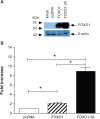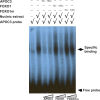FOXO1 Up-Regulates Human L-selectin Expression Through Binding to a Consensus FOXO1 Motif
- PMID: 23133314
- PMCID: PMC3486891
- DOI: 10.4137/GRSB.S10343
FOXO1 Up-Regulates Human L-selectin Expression Through Binding to a Consensus FOXO1 Motif
Abstract
L-selectin plays important roles in lymphocyte homing and leukocyte rolling. Mounting evidence shows that it is involved in many disease entities including diabetes, ischemia/reperfusion injuries, inflammatory diseases, and tumor metastasis. Regulation of L-selectin at protein level has been well characterized. However, the regulation of human L-selectin transcription remains largely unknown. To address transcriptional regulation of L-selectin, we cloned 1088 bp 5' of the start codon ATG. Luciferase analysis of the serial 5' deletion mutants located the core promoter region at -288/-1. A major transcription initiation site was mapped at -115 by 5'RACE. Transcription factors Sp1, Ets1, Mzf1, Klf2, and Irf1 bind to and transactivate the L-selectin promoter. Significantly, FOXO1 binds to a FOXO1 motif, CCCTTTGG, at -87/-80, and transactivates the L-selectin promoter in a dose-dependent manner. Over-expression of a constitutive-active FOXO1 increased the endogenous L-selectin expression in Jurkat cells. We conclude that FOXO1 regulates L-selectin expression through targeting its promoter.
Keywords: FOXO1; L-selectin; promoter; transcriptional regulation.
Figures







Similar articles
-
Transcriptional regulation of mouse L-selectin.Biochim Biophys Acta. 2009 Feb;1789(2):146-52. doi: 10.1016/j.bbagrm.2008.10.004. Epub 2008 Nov 11. Biochim Biophys Acta. 2009. PMID: 19041738 Free PMC article.
-
FOXO1 regulates L-Selectin and a network of human T cell homing molecules downstream of phosphatidylinositol 3-kinase.J Immunol. 2008 Sep 1;181(5):2980-9. doi: 10.4049/jimmunol.181.5.2980. J Immunol. 2008. PMID: 18713968
-
Counter regulation of ECRG4 gene expression by hypermethylation-dependent inhibition and the Sp1 transcription factor-dependent stimulation of the c2orf40 promoter.Gene. 2017 Dec 15;636:103-111. doi: 10.1016/j.gene.2017.08.041. Epub 2017 Sep 1. Gene. 2017. PMID: 28870864
-
Regulation of parathyroid hormone-related protein (PTHrP) gene expression. Sp1 binds through an inverted CACCC motif and regulates promoter activity in cooperation with Ets1.J Biol Chem. 1994 Aug 26;269(34):21428-34. J Biol Chem. 1994. PMID: 8063775
-
Dual mechanisms of regulation of transcription of luteinizing hormone receptor gene by nuclear orphan receptors and histone deacetylase complexes.J Steroid Biochem Mol Biol. 2003 Jun;85(2-5):401-14. doi: 10.1016/s0960-0760(03)00230-9. J Steroid Biochem Mol Biol. 2003. PMID: 12943729 Review.
Cited by
-
Lack of Ikaros cripples expression of Foxo1 and its targets in naive T cells.Immunology. 2017 Nov;152(3):494-506. doi: 10.1111/imm.12786. Epub 2017 Aug 23. Immunology. 2017. PMID: 28670688 Free PMC article.
-
Nicotinamide enhances natural killer cell function and yields remissions in patients with non-Hodgkin lymphoma.Sci Transl Med. 2023 Jul 19;15(705):eade3341. doi: 10.1126/scitranslmed.ade3341. Epub 2023 Jul 19. Sci Transl Med. 2023. PMID: 37467318 Free PMC article.
-
Eosinophilic Esophagitis in Esophageal Atresia.Front Pediatr. 2019 Nov 29;7:497. doi: 10.3389/fped.2019.00497. eCollection 2019. Front Pediatr. 2019. PMID: 31850292 Free PMC article. Review.
-
High-progesterone environment preserves T cell competency by evading glucocorticoid effects on immune regulation.Front Immunol. 2022 Sep 20;13:1000728. doi: 10.3389/fimmu.2022.1000728. eCollection 2022. Front Immunol. 2022. PMID: 36203559 Free PMC article.
-
Motility Matters: How CD8+ T-Cell Trafficking Influences Effector and Memory Cell Differentiation.Cold Spring Harb Perspect Biol. 2021 Aug 2;13(8):a038075. doi: 10.1101/cshperspect.a038075. Cold Spring Harb Perspect Biol. 2021. PMID: 34001529 Free PMC article. Review.
References
-
- Whelan J. Selectin synthesis and inflammation. Trends Biochem Sci. 1996 Feb;21(2):65–9. - PubMed
-
- Verdrengh M, Erlandsson-Harris H, Tarkowski A. Role of selectins in experimental Staphylococcus aureus-induced arthritis. Eur J Immunol. 2000 Jun;30(6):1606–13. - PubMed
-
- Ley K, Tedder TF, Kansas GS. L-selectin can mediate leukocyte rolling in untreated mesenteric venules in vivo independent of E- or P-selectin. Blood. 1993 Sep 1;82(5):1632–8. - PubMed
-
- Wang CC, Biben C, Robb L, et al. Homeodomain factor Nkx2-3 controls regional expression of leukocyte homing coreceptor MAdCAM-1 in specialized endothelial cells of the viscera. Dev Biol. 2000 Aug 15;224(2):152–67. - PubMed
-
- Arbones ML, Ord DC, Ley K, et al. Lymphocyte homing and leukocyte rolling and migration are impaired in L-selectin-deficient mice. Immunity. 1994 Jul;1(4):247–60. - PubMed
Grants and funding
LinkOut - more resources
Full Text Sources
Research Materials
Miscellaneous

